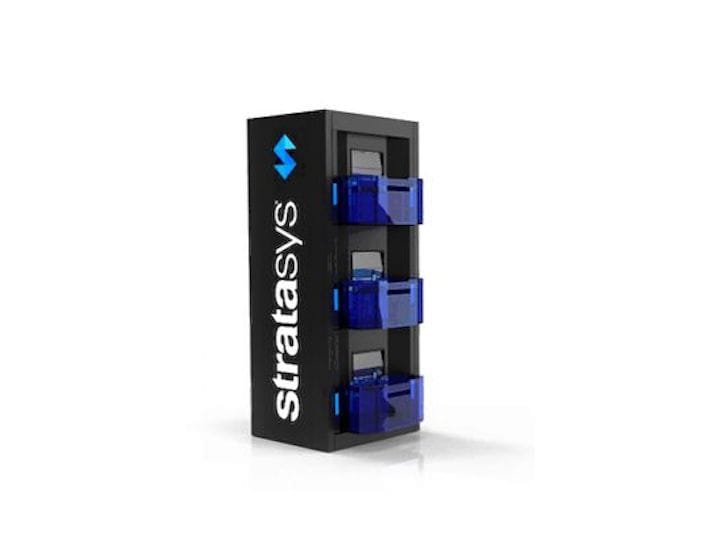![The Stratasys Continuous Build 3D Printer [Source: Stratasys]](https://fabbaloo.com/wp-content/uploads/2020/05/image-asset_img_5eb093efd8d3e.jpg)
Stratasys seems to be selling one of their “demonstration” technologies as a product now, but what happened to the others?
In the past few years we were fortunate enough to see first hand three very unusual technology demonstrations by Stratasys. These were considered quite notable at the time, and still to this day.
The first two 3D printing demonstrators were announced by Stratasys in the summer of 2016, when the company showed off technologies they had apparently been working behind the scenes on for many years.
The first was the Infinite Build 3D Demonstrator, a 3D printing system that was able to build objects of theoretically infinite length. They accomplished this by turning the build chamber on its side and simply allowing it to print “forever”. Objects would emerge on the side and continue outwards as long as you kept supplying the device with material (which turned out to be thermoplastic pellets.)
![The Stratasys Infinite Build Demonstrator [Source: Fabbaloo]](https://fabbaloo.com/wp-content/uploads/2020/05/image-asset_img_5eb093f038c11.jpg)
Of course, in practice you would never print “infinite” objects. What you would do is 3D print larger and longer objects. Stratasys felt there was a need for larger print volumes as they had been working with several industries on this problem. Specifically, transportation companies that required ever-changing interior panels that had to be kept in inventory for years. This would include aircraft, rail cars and subway cars. The Infinite Build demonstrator technology appears to fit that need exactly.
Composite 3D Printing
![The Stratasys Robotic Composite Demonstrator [Source: Fabbaloo]](https://fabbaloo.com/wp-content/uploads/2020/05/image-asset_img_5eb093f07cce1.jpg)
The second demonstrator was the Robotic Composite 3D Demonstrator, which was essentially a Stratasys composite material extruder fitted to the end of a Kuka robot, controlled by sophisticated multi-axis software from Siemens. This tech allows for the printing of highly complex 3D objects in composite material, whereas traditional composite layups have signifiant geometric limitations.
Then, in spring 2017, Stratasys announced the Continuous Build Demonstrator, which was an array of smaller 3D printers that were centrally controlled. While this concept has been produced by several other 3D printer manufacturers, Stratasys invented some unique features to enable actual production, including an ability to track the numerous parts produced by the array throughout their lifecycle.
Next Steps
All three of these were quite interesting and seemed very applicable to specific industries.
And then, nothing. We heard zip from Stratasys about these technologies for a couple of years.
There were even rumors that the company had stopped working on them, or even abandoned the technology. Having no other information from Stratasys, I half-suspected this might be the case, although it didn’t feel right because Stratasys is seeking new business models, and all three of these fit nicely into that strategy.
New Stratasys Continuous 3D Printer
Then I noticed on Stratasys’ product page there was a new product: the Continuous Build 3D Printer. This demonstrator, at least, was now an actual product. As far as I can tell, the product is much the same as the demonstrator we saw previously.
I asked Stratasys’ Craig Librett about the Continuous Build 3D Printer, who replied:
“Yes — it is now an official product — with North American customers onIy, specifically in the education market. Additionally, the availability date was January 1 of this year.”
This makes sense. But what about the other demonstrators? Librett explained:
“This [The Continuous Build 3D Printer] is indeed the first commercially available. The others are currently in beta with customers.”
Aha! So these are definitely not abandoned tech, and they are being used by customers today.
Stratasys Future Products
My thought here is that the two other not-yet-productized demonstrators are quite challenging in that they must fit within highly complex manufacturing environments, and that is what Stratasys is spending their time doing. Note that the Continuous Build 3D Printer is targeting the education market, which is far less demanding.
It’s very possible that once Stratasys works out the details with their beta customers, we may indeed see both of the other demonstration technology released as official products.
In fact, I think Stratasys is counting on it.
Via Stratasys











The debate over use of proprietary or open materials ecosystems is becoming a big topic in 3D printing.